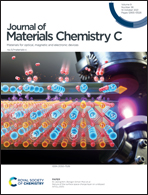A rosin-based dielectric polymer with intrinsic low dielectric constant and comprehensively excellent properties†
Abstract
It is known that the tremendous structural units in a polymer chain can result in a larger free volume of the bulk, which can effectively decrease the dielectric constant of the polymer. According to this design strategy, a novel rosin-based BCB monomer containing Si–O and characterized by a symmetrical molecular structure was successfully synthesized. Subsequently, an amorphous cross-linked network, with a dielectric constant of 2.44 and a dielectric loss of 2.02 × 10−3 at 1.0 MHz, was formed after the monomer was polymerized at an appropriate temperature. Additionally, the effects of the rosin skeleton on other properties of the modified BCB resin were studied. Compared with those of a BCB resin without a rosin skeleton, the dielectric properties, thermal stability, mechanical properties, and hydrophobicity of the rosin-modified BCB resin were significantly improved. The improvement of these properties is due to the presence of a hydrogenated phenanthrene ring in rosin, which is difficult to rotate and hinders the movement of the molecular chains in the modified BCB resin. Meanwhile, the rigidity and hydrophobicity of the hydrogenated phenanthrene ring can also improve the properties of the BCB resin. Thus, this study shows that the introduction of a rosin skeleton can significantly and comprehensively improve the properties of BCB materials.



 Please wait while we load your content...
Please wait while we load your content...